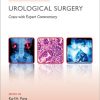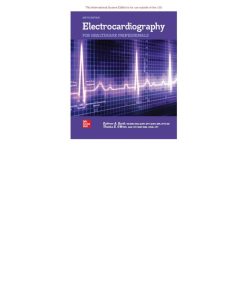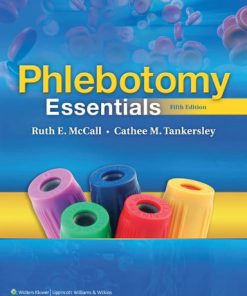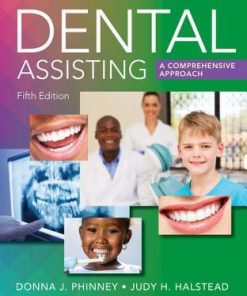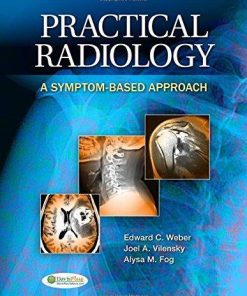(EBook PDF) Phlebotomy A Competency Based Approach 5th Edition by Kathryn ABooth full chapters 1260290484 9781260290486 full chapters
$50.00 Original price was: $50.00.$25.00Current price is: $25.00.
Phlebotomy: A Competency-Based Approach 5th Edition by Kathryn A. Booth – Ebook PDF Instant Download/DeliveryISBN:
Full download Phlebotomy: A Competency-Based Approach 5th Edition after payment.
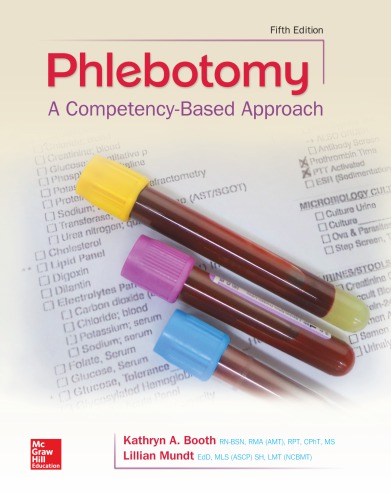
Product details:
ISBN-10 : 1260290484
ISBN-13 : 9781260290486
Author: Kathryn A. Booth
Phlebotomy: A Competency-Based Approach, Fifth Edition prepares users for a national phlebotomy certification examination, as well as providing phlebotomy skills training for health care students and health care personnel who are interested in mastering additional skills. With Phlebotomy’s pedagogy-rich format and plentiful Check Your Competency features, you can easily grasp not only essential phlebotomy skills and competencies, but also the critical soft skills needed for a successful transition from classroom to lab.
Phlebotomy: A Competency-Based Approach 5th Table of contents:
Chapter 1 Phlebotomy and Healthcare
Introduction
1.1 Phlebotomy
1.2 Phlebotomist’s Role
1.3 Healthcare Facilities
1.4 The Healthcare Team
1.5 The Medical Laboratory
1.6 Regulatory Agencies
1.7 Qualities of a Phlebotomist
Check Your Competency 1-1: Communication and Customer Service
Chapter 2 Safety and Preparedness
Introduction
2.1 Medical Biohazards
2.2 Personal Safety and Preparedness
Competency Checklist: Using an Eyewash Station
Competency Checklist: Safety Equipment in the Clinical Setting
Chapter 3 Infection Control
Introduction
3.1 Disease Transmission
3.2 Controlling Infection
Check Your Competency 3-1: Hand Hygiene
Check Your Competency 3-2: Using Personal Protective Equipment
Competency Checklist: Handwashing
Competency Checklist: Gowning, Gloving, and Masking
Chapter 4 Medical Terminology and Abbreviations
Introduction
4.1 Medical Language
4.2 Medical Abbreviations
4.3 Anatomical Terminology
Chapter 5 Body Systems and Related Laboratory Tests
Introduction
5.1 Integumentary System
5.2 Skeletal System
5.3 Muscular System
5.4 Lymphatic and Immune Systems
5.5 Respiratory System
5.6 Digestive System
5.7 Nervous System
5.8 Endocrine System
5.9 Cardiovascular System
5.10 Urinary System
5.11 Female and Male Reproductive Systems
5.12 Test Panels and Profiles
Chapter 6 The Cardiovascular System
Introduction
6.1 The Heart and Circulation
6.2 Blood Vessels
6.3 Veins Commonly Used for Phlebotomy
6.4 Composition of Blood
6.5 Hemostasis and Blood Coagulation
6.6 ABO and Rh Blood Types
Chapter 7 Patient and Specimen Requirements
Introduction
7.1 Laboratory Requisitions
7.2 Professional Communication
7.3 Healthcare Ethics and Law
7.4 Patient Identification
Check Your Competency 7-1: Patient Identification
7.5 Specimen Identification
7.6 Factors Affecting Specimen Quality and Test Results
7.7 Documenting Specimen Collection
Chapter 8 Blood Collection Equipment
Introduction
8.1 Common Blood Collection Equipment
8.2 Equipment Unique to Venipuncture
8.3 Equipment Unique to Microcollection
8.4 Additives and Color Coding
8.5 Order of Draw
8.6 Blood Collection Equipment Manufacturers
Competency Checklist: Order of Draw for Venipuncture
Competency Checklist: Order of Draw for Dermal (Capillary) Puncture
Chapter 9 Venipuncture
Introduction
9.1 Venipuncture
Check Your Competency 9-1: Basic Blood Collection
Check Your Competency 9-2: Tourniquet Application
9.2 Difficult Blood Draws
9.3 Venipuncture Complications
Competency Checklist: Routine Venipuncture (Evacuated Tube System)
Competency Checklist: Transferring Specimens to Tubes
Competency Checklist: Routine Venipuncture (Syringe)
Competency Checklist: Venipuncture Using a Butterfly and Syringe
Competency Checklist: Venipuncture Using a Butterfly and Evacuated Tube Adaptor
Chapter 10 Dermal (Capillary) Puncture
Introduction
10.1 The Dermal (Capillary) Puncture
10.2 Preparing for a Dermal (Capillary) Puncture
Check Your Competency 10-1: Dermal (Capillary) Puncture Preparation
10.3 Performing a Dermal (Capillary) Puncture
Check Your Competency 10-2: Performing a Dermal (Capillary) Puncture
10.4 Collecting the Dermal (Capillary) Specimen
Check Your Competency 10-3: Collecting the Dermal (Capillary) Specimen
Competency Checklist: Dermal (Capillary) Puncture on Finger
Competency Checklist: Dermal (Capillary) Puncture on Heel
Chapter 11 Blood Specimen Handling
Introduction
11.1 Specimen Transport
11.2 Special Specimen Handling
Check Your Competency 11-1: Forensic Testing Guidelines
11.3 Specimen Rejection
Competency Checklist: Specimen Handling: Temperature-Sensitive Specimens
Competency Checklist: Specimen Handling: Light-Sensitive Specimens
Competency Checklist: Maintaining a Chain of Custody
Competency Checklist: Centrifuge Operation
Chapter 12 Quality Essentials
Introduction
12.1 Maintaining Quality
12.2 Documenting Quality Control Activities
12.3 Quality Improvement Processes
Competency Checklist: Quality Assurance in the Laboratory
Competency Checklist: Temperature Quality Control
Chapter 13 Special Phlebotomy Procedures
Introduction
13.1 Blood Cultures
Check Your Competency 13-1: Cleaning the Blood Culture Site
Check Your Competency 13-2: Blood Culture Collection Comparison of Procedures
13.2 Glucose Testing
Check Your Competency 13-3: Glucose Testing
13.3 Neonatal Screening
Check Your Competency 13-4: Dermal (Capillary) Puncture State Testing on Infants
13.4 Peripheral Blood Smears
Check Your Competency 13-5: Thin Blood Smear
13.5 Blood Collection for the Blood Bank 360
Check Your Competency 13-6: Type and Cross-Match
13.6 Arterial Blood Collection
Check Your Competency 13-7: Arterial Puncture
13.7 Venous Access Devices
Competency Checklist: Blood Culture Procedure
Competency Checklist: Neonatal Testing
Competency Checklist: Preparation of Blood Smears
Competency Checklist: Specimen Collection for Type and Cross-Match
Chapter 14 Collection of Non-Blood Specimens
Introduction
14.1 Swab Specimens
Check Your Competency 14-1: Throat Swab Collection
Check Your Competency 14-2: Nasal Swab Collection
Check Your Competency 14-3: Nasopharyngeal Swab Collection
14.2 Sputum Specimens
14.3 Stool Specimens
14.4 Semen Specimens
14.5 Urine Specimens
Check Your Competency 14-4: Female Clean-Catch Urine Specimen Collection
Check Your Competency 14-5: Male Clean-Catch Urine Specimen Collection
Check Your Competency 14-6: 24-Hour Urine Specimen Collection
14.6 Other Non-Blood Specimens
Competency Checklist: Throat Swab Collection
Competency Checklist: Nasal Swab Collection
Competency Checklist: Nasopharyngeal Swab Collection
Chapter 15 Waived Testing
Introduction
15.1 Levels of Laboratory Testing
15.2 Erythrocyte Sedimentation Rate
Check Your Competency 15-1: Erythrocyte Sedimentation Rate Testing
15.3 Fecal Occult Blood Testing
15.4 Microhematocrit
15.5 Strep Screening
15.6 Urine Testing
Check Your Competency 15-2: Urine Chemical Screening
15.7 Point-of-Care Testing (POCT)
Check Your Competency 15-3: Glucose Point-of-Care Testing
Competency Checklist: Urine Chemical Screening
Competency Checklist: Point-of-Care Glucose Testing
Chapter 16 Practicing Professional Behavior
Introduction
16.1 Professional Behavior
16.2 Diversity in Healthcare
16.3 Risk Management
16.4 Coping with Stress
16.5 Professional Community
People also search for Phlebotomy: A Competency-Based Approach 5th:
phlebotomy a competency based approach sixth edition
phlebotomy a competency based approach answer key
what is competency based approach
what is competency based approach in teaching
phlebotomy a competency based approach pdf
Tags:
Phlebotomy,Competency,Approach,Kathryn ABooth,
You may also like…
Relationships & Lifestyle - Personal Growth & Inspiration
Uncategorized
Uncategorized
Developing Helping Skills: A Step by Step Approach to Competency 3rd Edition, (Ebook PDF)
Uncategorized
Uncategorized



